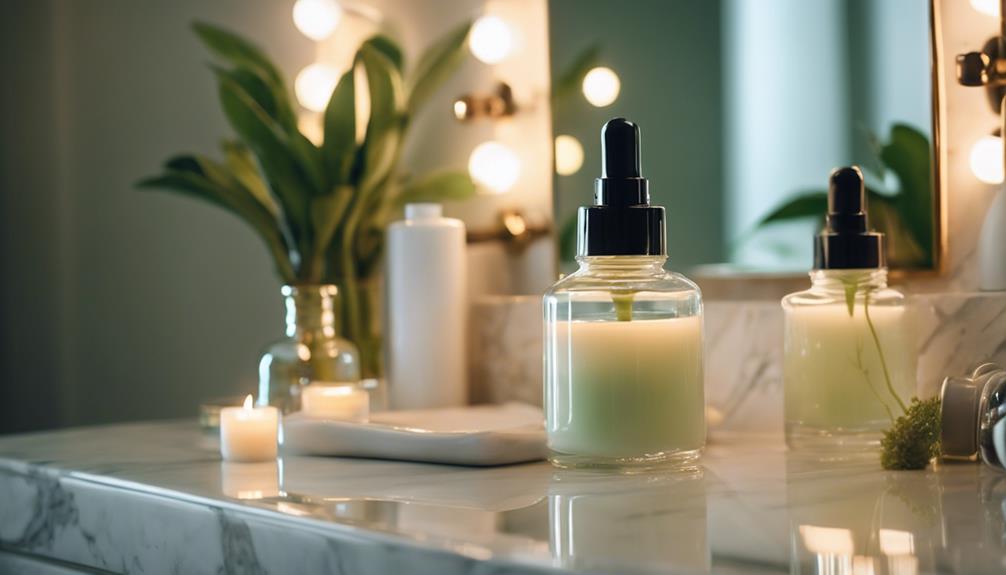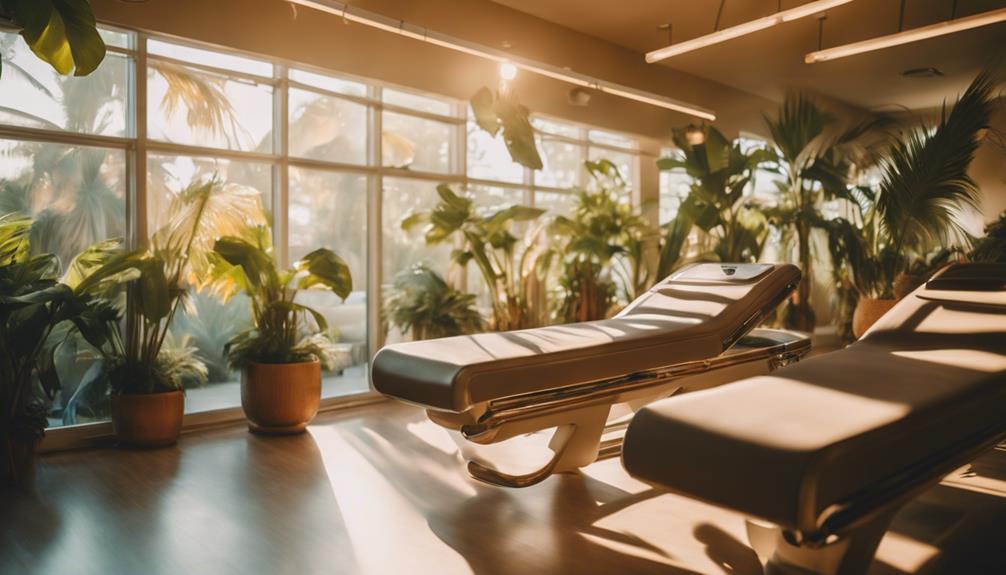For those with dry skin, creating an effective skincare routine involves focusing on hydration and protecting your skin’s barrier. In the morning, start by cleansing with a gentle, hydrating cleanser, followed by an alcohol-free toner. Apply a serum containing hyaluronic acid, and then lock in moisture with a rich moisturizer that includes ceramides. In the evening, repeat the same steps with a gentle cleanser, hydrating toner, and nourishing serum. Finish off with an occlusive moisturizer and consider adding a facial oil for extra hydration. Remember to stay hydrated by drinking plenty of water, and adjust your routine as needed based on the season to maintain healthy and happy skin. Stay tuned for more essential skincare tips!
Key Takeaways
- Start your morning routine with a gentle, hydrating cleanser followed by a toner rich in vitamin E or aloe vera.
- Incorporate a serum containing hyaluronic acid to attract moisture before applying a rich moisturizer with ceramides and niacinamide.
- In the evening, use an oil or gel cleanser, followed by a hydrating toner and a nourishing nighttime serum.
- Seal in moisture with an occlusive moisturizer and consider using a face oil for enhanced hydration.
Understanding Dry Skin
Understanding dry skin means recognizing how a compromised skin barrier leads to rapid water loss, resulting in symptoms like itchiness and flakiness. Your skin's hydration levels are essential for maintaining healthy skin, and when moisture dips below 20%-35%, dryness becomes apparent. Environmental factors, such as low humidity and cold weather, can exacerbate this condition, making it imperative to adjust your skincare routine accordingly.
As you age, your skin naturally produces less oil, which can further weaken your skin barrier and contribute to dehydrated skin. Incorporating moisturizing ingredients, like hyaluronic acid, can help retain moisture and bolster that barrier. These ingredients work by attracting water to your skin, keeping it plump and hydrated.
To combat dry skin, focus on a skincare routine that prioritizes hydration. Look for products that contain effective moisturizing ingredients to help restore your skin's moisture levels. Regularly applying these products can prevent the discomfort associated with dry skin and support overall skin health.
Key Ingredients for Hydration

To keep your dry skin hydrated, look for key ingredients that effectively replenish moisture and strengthen your skin barrier.
Start with hyaluronic acid, which can hold up to 1,000 times its weight in water, making it a powerhouse for attracting and retaining moisture.
Ceramides are also essential; they restore the skin barrier and lock in moisture, preventing transepidermal water loss.
Include glycerin in your routine, as this humectant draws moisture from the environment into your skin, enhancing hydration and improving texture.
Niacinamide is another beneficial ingredient; it not only hydrates but also reinforces the skin barrier and helps even out skin tone.
Morning Skincare Routine

A morning skincare routine for dry skin should always begin with a gentle, non-foaming cleanser that hydrates without stripping your skin's natural oils. Look for one with hydrating ingredients like glycerin to maintain moisture levels.
After cleansing, use an alcohol-free toner enriched with components such as vitamin E or aloe vera. This helps prepare your skin for the next steps.
Next, apply a serum containing hyaluronic acid. This powerful ingredient attracts moisture and enhances hydration, making your skin appear fuller and more plump.
Following the serum, choose a rich moisturizer that includes ceramides and niacinamide. These ingredients lock in hydration and support your skin barrier, protecting it from environmental stressors.
Nighttime Skincare Routine

To kick off your nighttime skincare routine, start with a gentle oil or gel cleanser to remove makeup and impurities without compromising your skin's natural oils.
Next, apply a hydrating toner packed with ingredients like hyaluronic acid to boost moisture retention while you sleep.
This sets the stage for the nourishing treatments that follow, ensuring your dry skin gets the care it needs overnight.
Cleansing and Makeup Removal
Start your nighttime skincare routine by gently cleansing your face with an oil-based or cream cleanser to effectively remove makeup and impurities without drying out your skin. This initial step is vital, especially for dry skin, as it helps maintain your skin barrier.
Consider these three essential steps for ideal cleansing:
- Double Cleansing: If you wear heavy makeup or sunscreen, start with a gentle oil-based cleanser, followed by a hydrating micellar water or cleansing balm rich in glycerin or hyaluronic acid. This guarantees complete removal without stripping your skin's natural oils.
- Rinse with Lukewarm Water: Always rinse your face with lukewarm water to prevent further drying. Hot water can exacerbate dryness and irritation, so stick to a comfortable temperature.
- Apply a Hydrating Toner: Immediately after cleansing, use an alcohol-free hydrating toner with soothing ingredients. This helps replenish moisture and prepares your skin for the next steps in your routine.
Hydrating Treatment Application
After cleansing, apply a hydrating toner to replenish moisture and set the stage for your nighttime treatments. This step enhances overall hydration and prepares your skin for better absorption of the products that follow.
Next, incorporate a nighttime serum rich in hydrating ingredients like niacinamide, peptides, or hyaluronic acid. These powerful elements combat dryness and support skin repair while you sleep.
Once you've applied your serum, use a rich, occlusive moisturizer to lock in that hydration and support your skin barrier throughout the night. Look for moisturizers containing ceramides and glycerin for peak effectiveness.
Lastly, consider adding a face oil as the final touch to your routine. This will enhance moisture retention and provide an extra layer of hydration, especially beneficial for dry skin types.
| Step | Product Type |
|---|---|
| 1. Cleansing | Gentle Oil or Gel Cleanser |
| 2. Hydrating Toner | Replenishes moisture |
| 3. Nighttime Serum | Contains hyaluronic acid |
| 4. Occlusive Moisturizer | Locks in hydration |
Moisturizing Strategies

When it comes to moisturizing strategies, knowing the right ingredients is essential for your dry skin.
You'll want to focus on application techniques that maximize hydration while effectively layering products for the best results.
Let's break down the key points to guarantee your skin stays supple and nourished.
Key Moisturizing Ingredients
To effectively combat dry skin, focus on key moisturizing ingredients that replenish moisture and strengthen your skin barrier. By incorporating the right components, you can enhance hydration, improve moisture retention, and soothe irritation.
Here are three essential types of ingredients to look for:
- Humectants: Ingredients like hyaluronic acid and glycerin attract moisture from the environment into your skin, providing much-needed hydration and a plumping effect.
- Emollients: Products containing petrolatum, shea butter, or cocoa butter help replenish moisture levels, improving your skin barrier function and overall texture.
- Occlusives: Beeswax, argan oil, and jojoba oil create a protective layer on your skin's surface, preventing trans-epidermal water loss and ensuring long-lasting hydration.
Additionally, incorporating ceramides can restore and maintain your skin barrier, while niacinamide enhances hydration and soothes irritation.
By focusing on these key moisturizing ingredients, you'll be well on your way to achieving a healthier, more hydrated complexion.
Application Techniques
Applying your moisturizer correctly can greatly enhance its effectiveness in combating dry skin.
Start by patting your skin dry with a towel instead of rubbing, guaranteeing it's slightly damp before applying any products. This helps lock in moisture from your bath, preventing it from evaporating from the skin's surface.
When using application techniques, employ a layering technique: begin with a hydrating serum like hyaluronic acid, then apply your moisturizer. This method not only provides hydration but also sets the stage for maximum moisture retention.
For an added boost, consider the 'moisturizer sandwich' approach—apply a hydrating serum, follow it with your moisturizer, and seal everything with an occlusive layer, like face oil.
In dry environments, don't forget to use a humidifier to enhance skin hydration and combat moisture loss throughout the day and night.
By following these steps, you'll guarantee your skincare routine effectively nourishes your dry skin, leaving it feeling soft and supple.
Layering Products Effectively
Layering products effectively is crucial for maximizing hydration and guaranteeing your dry skin stays nourished throughout the day. To achieve peak moisture retention, follow these steps in your skincare routine:
- Start with Hydrating Serums: Apply hydrating serums containing hyaluronic acid or glycerin on damp skin. This boosts hydration and enhances absorption.
- Follow with Moisturizers: Next, layer on a rich moisturizer that includes occlusive agents like ceramides or squalane. This locks in hydration and prevents moisture loss throughout the day or night.
- Seal with Facial Oils: For your nighttime routine, finish off with facial oils. They provide additional nourishment and seal in all the moisture you've layered before.
Remember to layer products from thinnest to thickest consistency. This method guarantees that each product penetrates effectively, maximizing hydration for your dry skin.
You can also refresh your skin during the day with a hydrating mist to maintain moisture levels, especially in dry or air-conditioned environments.
Additional Hydrating Tips

Incorporating a humidifier into your living space can considerably boost moisture levels, especially during those dry winter months. This simple addition helps to hydrate your skin by maintaining ideal humidity, preventing excessive dryness.
Remember to layer your hydrating products effectively, starting with lighter serums and finishing with thicker creams to lock in moisture.
In addition to topical treatments, drinking at least 2 liters of water daily is important. Including hydrating foods, like cucumbers and oranges, can further enhance skin hydration from within. These foods not only replenish moisture but also provide essential nutrients for your skin.
Be mindful of your shower habits; avoid hot water, which can strip your skin's natural oils, leading to increased dryness and discomfort. Instead, opt for lukewarm showers to preserve your skin's barrier.
Lastly, regularly assess your skincare routine to adapt to seasonal changes. Your skin's hydration needs can vary with the weather, so it's important to tweak your products and habits accordingly.
What Are the Best Hydrating Tips for Dry Skin in a Skincare Routine?
If you have dry skin, incorporating proper hydration tips for dry skincare into your routine is crucial. Start by using a gentle cleanser and a hydrating moisturizer. Also, consider adding a hyaluronic acid serum and drinking plenty of water to keep your skin hydrated from the inside out.
Conclusion
To keep your dry skin hydrated, remember that about 40% of people experience some form of dry skin at some point in their lives, making your journey quite common.
By following a tailored skincare routine and incorporating hydrating ingredients, you can greatly improve your skin's moisture levels.
Don't forget to stay consistent with your morning and nighttime routines, and always listen to your skin's needs.
With these tips, you'll achieve the soft, supple skin you desire!









